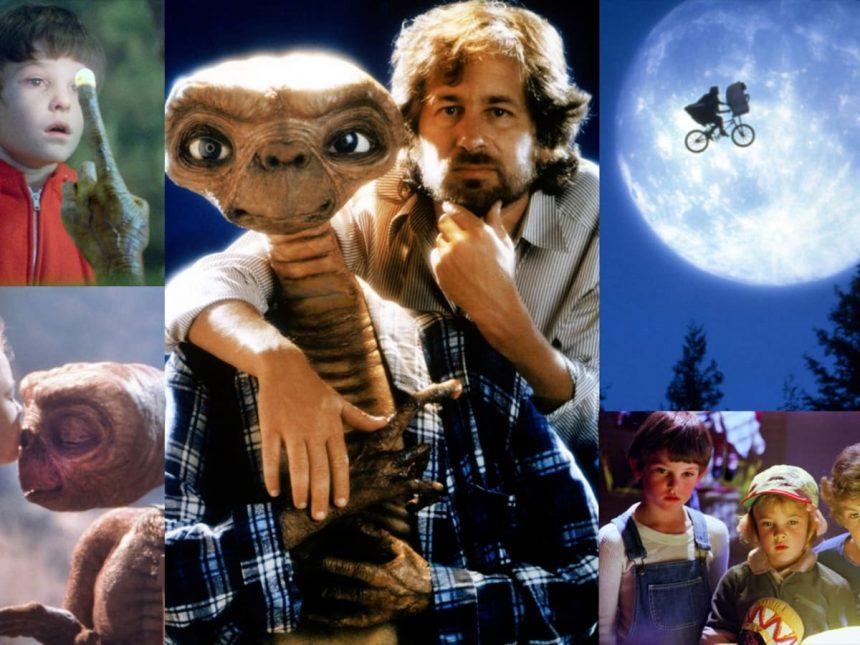More than four decades after its 1982 release, E.T.: The Extra-Terrestrial continues to captivate audiences with its heartfelt story, groundbreaking effects, and timeless themes. Directed by Steven Spielberg, this cinematic masterpiece has become one of the most beloved films in history. Dive into these 15 behind-the-scenes facts that reveal how this extraordinary film came to life and why it remains a cultural touchstone.
1. E.T.’s Design Was Inspired by Multiple Sources

The unforgettable look of E.T. was the result of a collaborative effort led by legendary sculptor Carlo Rambaldi, who previously worked on King Kong (1976). Rambaldi aimed to create a character that was both alien and endearing, blending unique features with expressive, emotive qualities.
2. Spielberg Originally Envisioned a More Alien Appearance

In early designs, E.T. looked far more alien-like, with bug eyes and intimidating features. Spielberg realized this vision might frighten audiences and opted for a softer, friendlier appearance, giving E.T. his now-iconic charm.
3. E.T.’s Voice Came from an Unusual Mix of Sounds

Sound designer Ben Burtt crafted E.T.’s voice by blending animal sounds—including those of a walrus, coyote, and elephant—with his own voice. The result was a one-of-a-kind sound that felt otherworldly yet relatable.
4. Drew Barrymore Shone at Just Six Years Old

Drew Barrymore auditioned for the role of Gertie at age six, wowing Spielberg with her natural charisma. Her performance made Gertie one of the most memorable child characters in cinema, launching Barrymore into stardom.
5. The Iconic Bicycle Scene Was Nearly Cut

The magical flying bicycle sequence, now synonymous with E.T., was originally written as a joke. But after seeing the test footage, Spielberg insisted it stay, making it one of the film’s most iconic moments.
6. “Phone Home” Was Improvised

E.T.’s famous line, “Phone home,” wasn’t in the original script. It was an improvised addition during filming that became the movie’s signature catchphrase and one of its most emotional highlights.
7. E.T.’s Reactions Were Often Genuine

E.T. was brought to life through a combination of puppetry and an actor in a suit. Many of his reactions captured on film were genuine, resulting from the puppeteers and actors working in real-time to make the character feel alive.
8. The First Draft Was Much Darker

Melissa Mathison’s original screenplay had a darker tone, particularly in scenes involving government agents. Spielberg pushed for a lighter, more family-friendly approach, which ultimately defined the film’s heartwarming legacy.
9. It Was Almost Called “A Boy’s Life”

The movie’s original working title, A Boy’s Life, reflected its focus on Elliott’s perspective. As the story evolved to emphasize E.T., the title was changed to E.T.: The Extra-Terrestrial, shifting the spotlight to the alien.
10. E.T.’s Small Stature Was Movie Magic

The actor inside the E.T. suit, Tamara De Treaux, was taller than the character appeared on screen. Clever camera angles and practical effects helped maintain the illusion of E.T.’s diminutive size.
11. Spielberg’s Subtle Cameo

There’s a rumored Steven Spielberg cameo in the film during a scene where E.T. watches The Wizard of Oz. While some claim to have spotted him, his appearance remains a fun mystery for eagle-eyed fans.
12. A Record-Breaking Box Office Smash

E.T. was an unprecedented financial success, becoming the highest-grossing film of its time, surpassing Star Wars. Spielberg held the record until Jurassic Park (1993), another of his films, claimed the title.
13. John Williams’ Score Won an Oscar

John Williams’ hauntingly beautiful score earned him an Academy Award for Best Original Score. The music remains an integral part of the film’s emotional impact, with “E.T.’s Theme” standing as one of Williams’ most beloved compositions.
14. E.T.’s Glowing Heart Was a Practical Effect

E.T.’s glowing chest, affectionately called his “heartlight,” symbolized his connection to Elliott and his home. The effect was achieved using colored lights embedded in the costume, combined with strategic camera techniques.
15. Revolutionary Special Effects

E.T. pushed the boundaries of 1980s filmmaking. Practical effects, miniatures, and blue-screen technology were used to create the awe-inspiring visuals, including the iconic flying bike scene, setting a new standard for science fiction films.
E.T.: The Extra-Terrestrial endures as a testament to the power of storytelling, innovation, and heartfelt connections. Its universal themes of friendship, family, and finding one’s way home resonate as deeply today as they did over 40 years ago.





